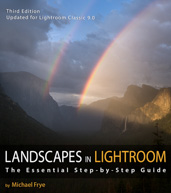In the Moment:
Michael Frye's Landscape Photography Blog
by Michael Frye | Sep 21, 2015 | Yosemite Photo Conditions
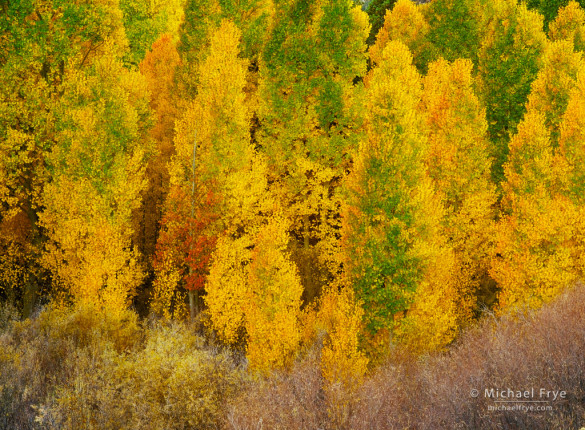
Quaking aspens, Lee Vining Canyon, October 24, 2003
Claudia and I just returned from our annual trip to the Millpond Music Festival and (as Joe Craven puts it) “consciousness-raising event.” We had a wonderful time, as usual. The festival may or may not have raised my consciousness, but it sure was relaxing and fun.
Since the festival takes place in Bishop, on the eastern side of the Sierra Nevada, the trip gives me a chance to check on the early fall color over there. Every year, it seems, some early-changing leaves lead to online predictions that the aspens will turn early. This year I’ve also heard a lot of speculation about the effect the drought will have on the autumn color, and even seen a few actual reports of aspens turning brown and dropping their leaves early.
Driving down to Bishop last Friday, the color didn’t look early at all. There were some yellow and lime-green aspens at the mouth of Warren Canyon (along Highway 120 in upper Lee Vining Canyon), and some lime-green trees on Parker Bench, but everything else looked dark green. Warren Canyon and Parker Bench are both high-elevation, early-changing locations, so that all looked pretty typical for this time of year.
(more…)
by Michael Frye | Aug 9, 2015 | Night Photography
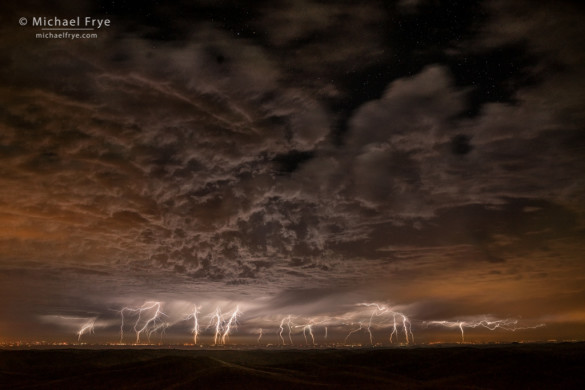
Lightning over the San Joaquin Valley from the Sierra Nevada foothills, California, USA
This summer I’ve often heard my fellow Californians making comments like, “Weird weather we’re having,” or “Interesting weather, isn’t it?” Yes indeed. Typically most of the state receives no precipitation from May through September, but this summer we’ve had lots of subtropical moisture drifting northward into the state, triggering showers and thunderstorms. The rains have mostly been light and scattered, so haven’t made any real dent in the drought, but have created interesting conditions for photography.
Last Thursday forecasters predicted another subtropical surge approaching, but we didn’t see much sign of it at our house. Then Claudia and I got into our hot tub around 10:30 p.m. (our nightly ritual before going to bed) and immediately noticed distant flashes of lightning. We couldn’t figure out where they were coming from at first; maybe the west? So I got out of the tub to check radar images, and saw that the nearest storms that could possibly be creating lightning were near the coast! That seemed impossibly far, but then last summer at Mono Lake, during our Starry Skies workshop, we saw distant flashes of lightning, and they turned out to be in eastern Nevada, 200 miles away. So yes, it was indeed possible to see flashes from lightning in the coast ranges, only 80 miles from our house.
(more…)
by Michael Frye | Jul 6, 2015 | Composition, Light and Weather
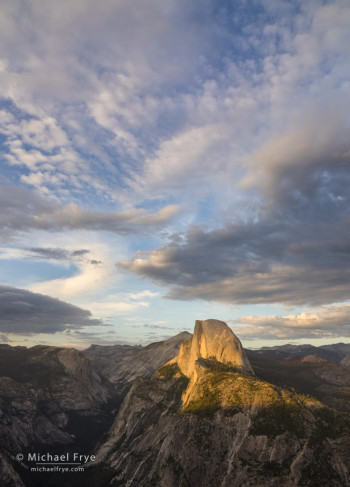
Half Dome from Glacier Point, late afternoon, Yosemite; for a brief moment the clouds formed a zigzag pattern above Half Dome.
Last week I mentioned that the weather forecast called for monsoonal moisture to move up into the Sierra Nevada from the south, with possible showers and thunderstorms. And sure enough, things unfolded pretty much as predicted. Rain was very localized; we got sprinkled on a couple of times at our house in Mariposa, but other nearby areas got dumped on when they received a direct hit from a thunderstorm.
Wednesday night brought thunder to the foothills near our house – that’s when I made the lightning photograph from my last post. But we saw interesting clouds all week. Claudia and I made two trips to Glacier Point, and I also photographed some beautiful moonlit clouds from our driveway, and made a trip into the lower foothills, where I found some striking, colorful sunbeams.
What do all these photographs have in common – aside from clouds? Patterns. All of these images have some kind of repeating pattern or design in the clouds.
(more…)
by Michael Frye | Jul 3, 2015 | Night Photography, Travels and Stories
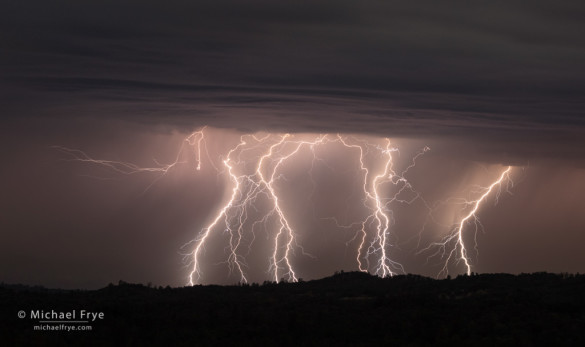
Lightning over the Sierra Nevada foothills, Mariposa County, CA, USA
We had some pre-Fourth-of-July fireworks here Wednesday night. At about 11:00 p.m. I let our dog Rider out before going to bed, and noticed flashes in the sky to the south. Sleep could wait! Claudia and I headed to a nearby viewpoint on Triangle Road, and saw lightning in three separate storm cells to the southeast, south, and southwest.
When watching thunderstorms you often only see cloud-to-cloud lightning, but on this night we could see some distinct bolts hitting the ground. I watched closely to try to determine where the most lightning activity was taking place. My first try didn’t work, but then another spot further to the right seemed to become more active, so I pointed my camera there, locked the tripod, and captured a series of 30-second exposures (each at f/9.5, 800 ISO). This photograph is a blend of five separate frames capturing seven or eight lightning bolts.
(more…)
by Michael Frye | Jul 1, 2015 | Reviews
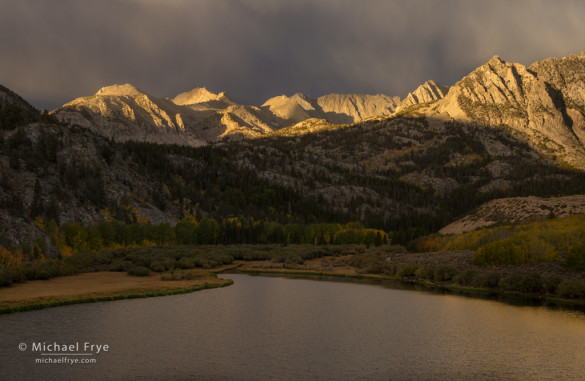
First light on peaks above North Lake, Bishop Creek Canyon, Inyo NF, CA, USA
In my recent post about high-resolution cameras, I stressed the importance of sharp lenses to get the most out of these 36+ megapixel sensors. But lens sharpness is an issue with any camera – at least when you start making larger prints. Even with a 16- or 20-megapixel sensor, lenses make a significant difference in large prints (16×20 inches and up). This is especially true in the corners; most professional-quality lenses are sharp enough in the center (at least with middle apertures like f/8 or f/11) for even a 36-megapixel camera. It’s the corners and edges that separate the decent lenses from the great ones. Those great ones are hard to find, and tend to be expensive.
Wouldn’t it be nice if you could fix imperfect lenses with software? Well yes, of course. But my experience with such fixes hasn’t been good. I’ve seen some great before-and-after examples online showing a blurry photo fixed with software, but when I’ve tried those programs myself I’ve invariably been disappointed. These cures tend to be just more-sophisticated sharpening methods, which may help a little, but if you apply more than a small amount things get really crunchy, or you see other weird artifacts. I can usually do just as well by selectively adding more sharpening to the corners in Lightroom or Adobe Camera Raw.
Piccure+
A few months ago I stumbled across another program that promised to help with fuzzy images, called Piccure+. I decided to download the free trial, and found that it worked surprisingly well. It’s not a magic bullet; there’s really no substitute for sharp lenses. But it can help with those soft corners, or overall softness caused by diffraction. Like any of these tools, it will definitely make the image look too crunchy if you overdo it, but I’ve been able to push the sharpening effect further in Piccure+ than with other software I’ve used, with good results and minimal artifacts.
(more…)












